For those interested in history, the new resources available online, especially old newspapers, provide a wealth of information and odd stories from the St. Croix Valley.
Warning: we take no position on whether the articles we send are actually true and the newspapers of yore were not above a bit of sensationalizing from time to time.

If your lawn looks something like this today, and dandelions are invading your garden, you shouldn’t feel too sorry for yourself. It could be much worse.

Consider the woman from Eastport who, as reported in the New England Farmer in 1831, had to deal with dandelions in her garden weighing 4 lbs, five ounces. Imagine weeding a few hundred of these monsters whose roots must have been a foot deep at least. The Guinness Book of World records gives the honor of the world’s largest dandelion to one found in Ontario, 70 inches high but there appears to be no established weight record for dandelions, so 4 pounds, 5 ounces and Eastport still holds the title as far as we can tell. As Eastport loves festivals, we’re looking forward to next year’s spring “Dandelion Festival”.
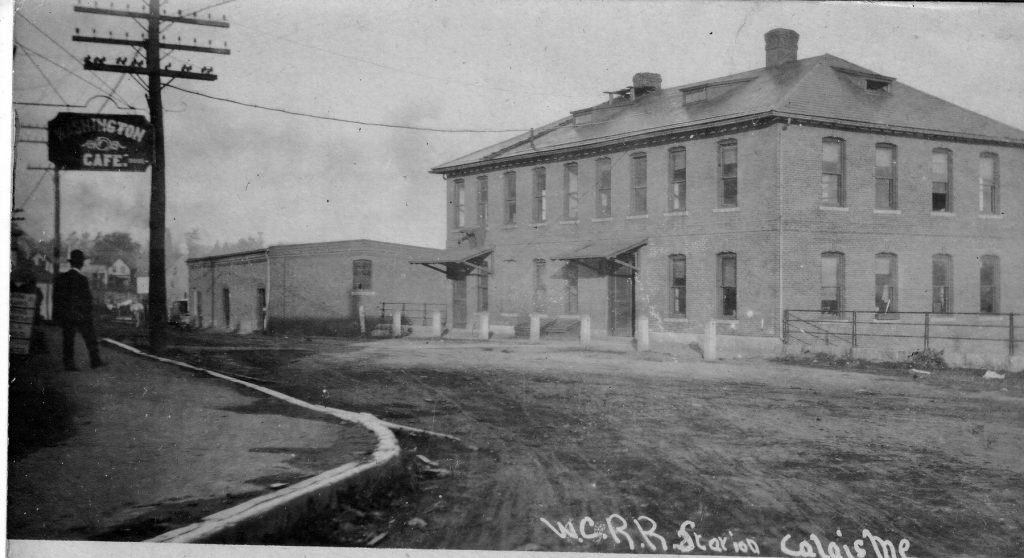
In the 1800s, the Calais jail was located on Hog Alley, just across the street from the railroad station and next to the Washington Cafe seen at the far left in the photo. In those days the jail was called the “Lockup”, but if the newspapers are any indication, the “Lockup” had an open door policy. Part of the problem may have been freedom was on view from the windows of lockup, St. Stephen being only a few hundred yards across the river and prisoners took advantage of the opportunity to cross the line on a regular basis. Usually they just walked out when the jailer was otherwise occupied. On other occasions they had help from friends and neighbors.
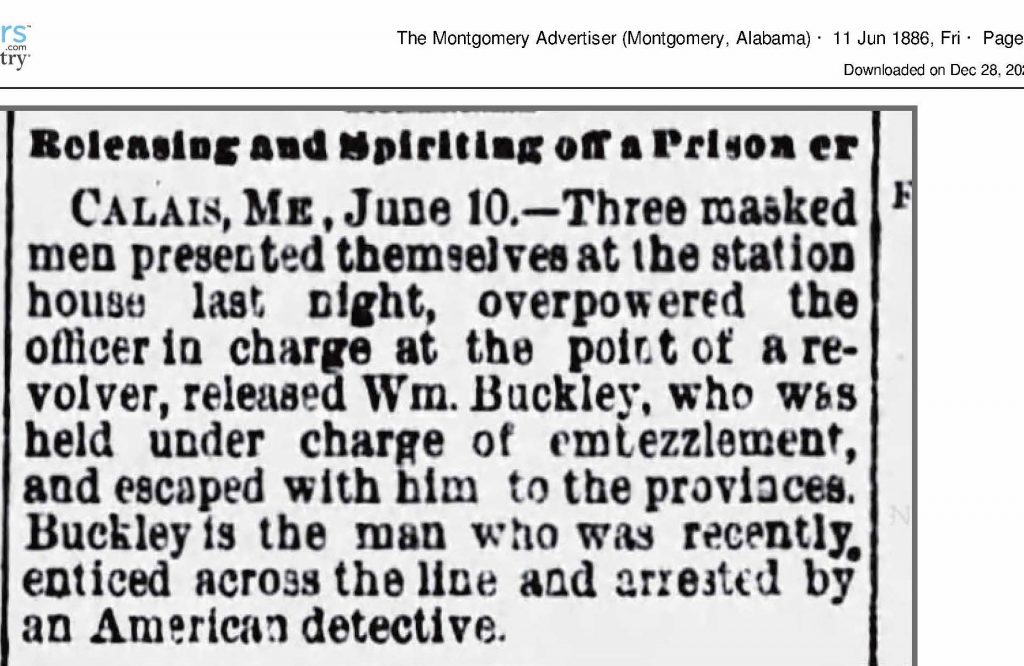
The Montgomery Alabama Advertiser reported a typical jailbreak in 1886 when a U.S felon who had been hiding out in New Brunswick had been lured back across the border by a U.S. detective, arrested and entrusted to Calais authorities. His friends took little time relieving the jailer of his prisoner.
The Boston Globe reported:
Jail break: June 10, 1886 Boston Globe:
RELEASED BY MASKED MEN.
Police Station at Calais Me Raided and a Prisoner Set Free. Calais, Me., June 10.
Last night, about 9.30. three men masked, and otherwise disguised through themselves upon Deputy Marshal Watson, who was standing in front of the door of the police station, and crowding him within the building with cocked revolvers, compelled him to remain silent. They then took his keys, and while two remained with him the other opened the cell door and released A. M. Buckley confined there awaiting a hearing before the governor on application of Massachusetts authorities for his extradition. After releasing Buckley, the four men hurriedly withdrew and crossed the river into New Brunswick. On their way to the stationhouse the men drew a revolver on a young man who was loitering in that vicinity and ordered him to “get,” which, he discreetly did. He gave an alarm, but too late to be of service. The police profess ignorance as to who the parties were, but if Buckley’s son, who is in the vicinity, should come across the line, they would be glad to see him.
Prisoners escaped from the Calais “Lockup” with such regularity that offenders were often rushed before the City Magistrate within hours of arrest, tried, convicted and sentenced to Machias before they could escape to New Brunswick although not a few probably escaped when being transported to the Machias jail. Even the first bicycle thief in Washington County, who stole a bike in Eastport in the 1880s and was apprehended in Calais, escaped from the lockup within hours of his arrest which brings us to our next topic:
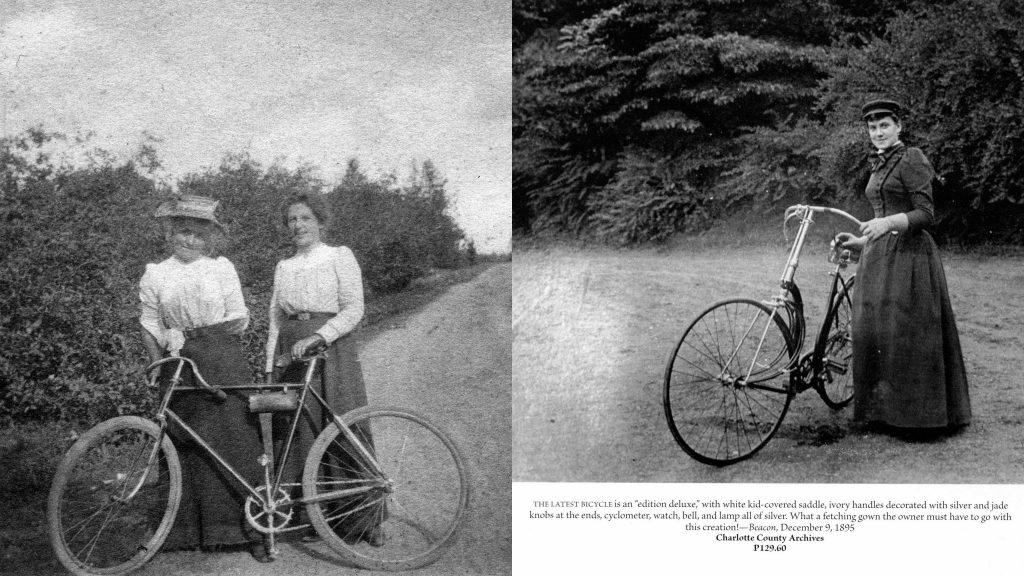
Beginning in the 1880s the “wheel”, or as we know it now, the bicycle, was all the rage. Ladies, of course were as enthusiastic about riding as men, but were hampered by the conventions of the day, one of which was that ladies did not wear pants in public and skirts were not especially well adapted to riding the “wheels” of the early years (or the later years for that matter).

The first solution women found to address the problem was “riding bloomers” which became popular in less conservative parts of the country. Sadly for our local ladies the St. Croix Valley was not such an area.
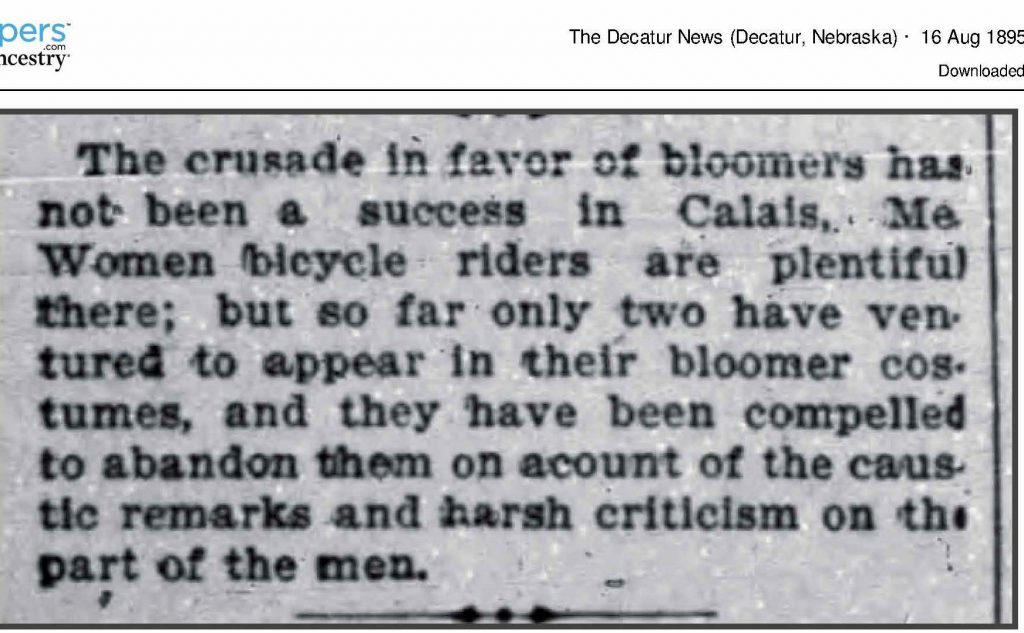
As you can see in the photo above, local women continue to conform to local attitudes in the early days. All of our photos of women riding bikes show them in dresses. Even a divided skirt under a long coat was considered controversial. Only after the First World War did attitudes change.
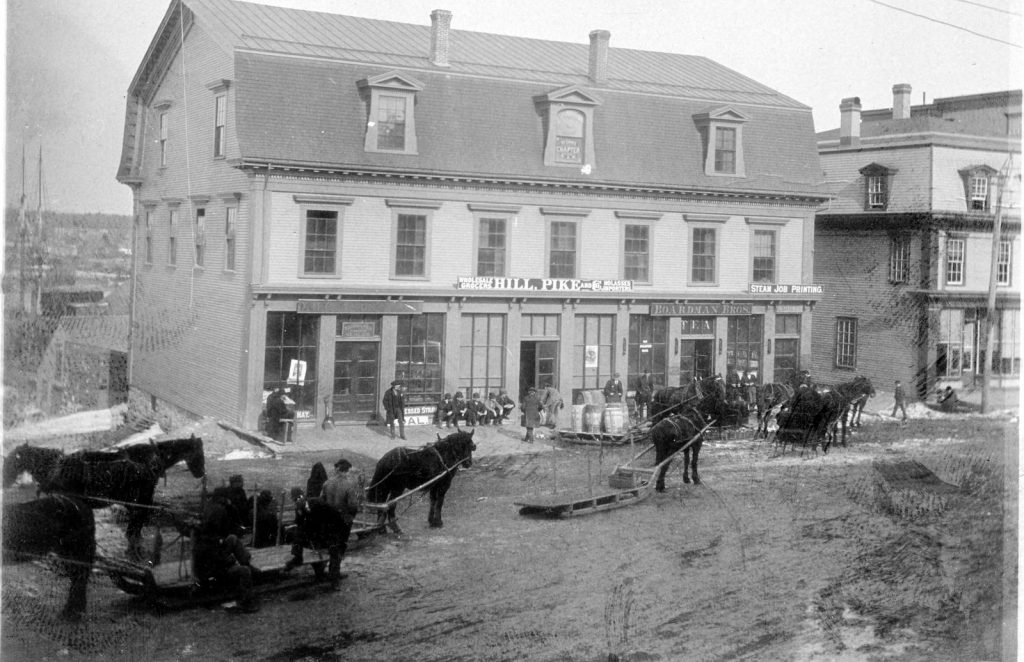
The Gilman King family was part of the “upper crust” of Calais society from the mid to late 1800s. Gilman founded a large mercantile business on both sides of the border and built the King Block shown above. At one time this site was the center of the city’s commercial district and the family business, trading as Gilman King and Sons, did quite well financially. Gilman’s son Willard B. King was one of the partners and a successful businessman. He was also quite a ladies man which landed him in court in 1866.
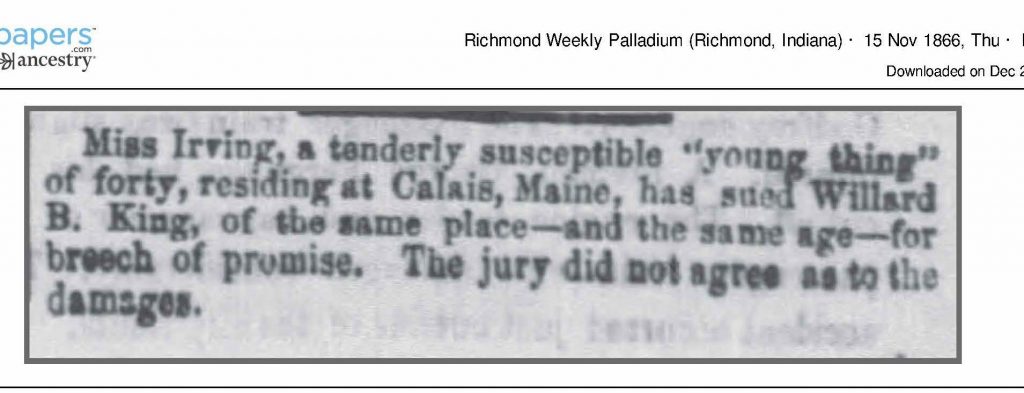
Breach of promise cases were not uncommon in the 1800s and it is still possible to bring such an action in about half of the states today. The promise and breach were usually easier to prove than damages. The plaintiff had to show some financial or other significant damage to her prospects and in Miss Irving’s case the court appeared to find a breach but could not establish damages which resulted in a Pyrrhic victory for Miss Irving. Willard would certainly have been able to pay given his financial wherewithal and he was very eligible at the time, his first wife having died in June of 1865. He was not long remarrying, not once but twice more and died in 1897. All three of his wives are buried with him in the Calais cemetery.
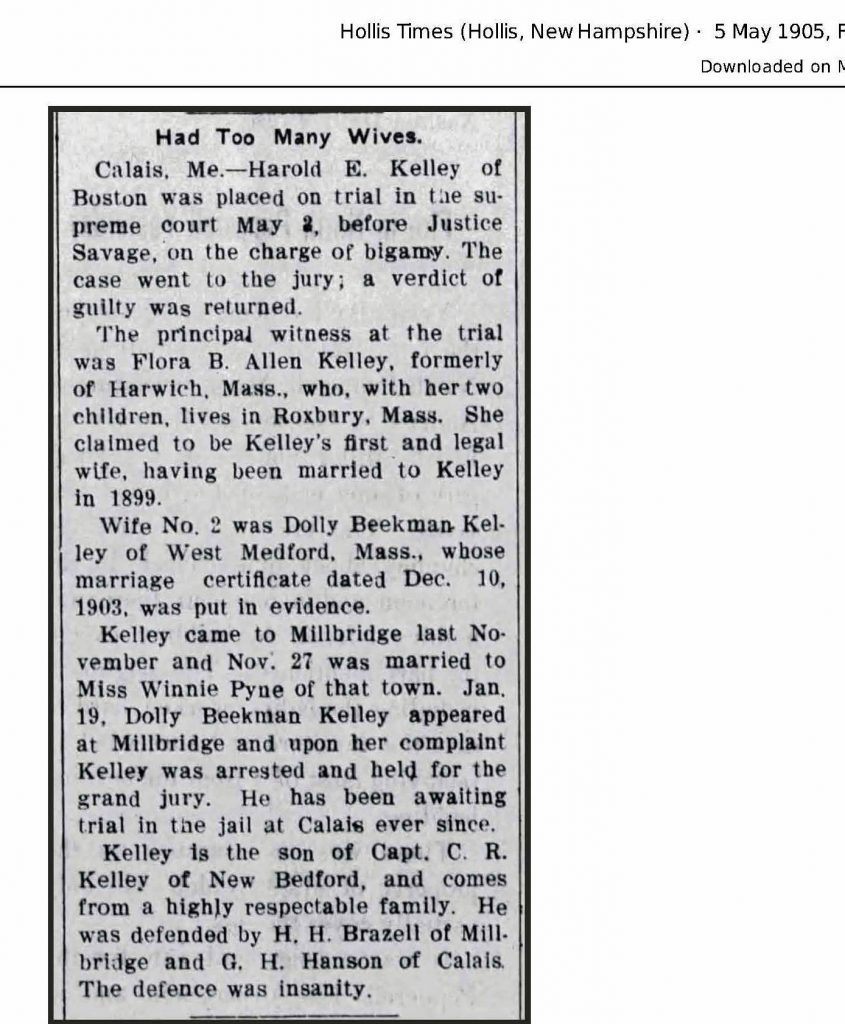
In the same vein as breach of promise, the crime of bigamy was much in the news in the 1800s but rarely prosecuted today. Harold Kelley had but three wives – a piker by contemporary and historical standards. The famous Fred Hipp, or Giovanni Vigliotto (or, well, who’s counting names), had 105 wives over his career as a serial bigamist.
Especially in the 1800s, it was very easy to simply walk away from an unhappy situation and begin a new life elsewhere, preferably far enough from your past life to avoid chance encounters with those who might recognize you. Even assuming a new identity was not a problem. There were no ID cards, government or otherwise, no driver’s licenses and few photographs – not even a mug shot of that embarrassing incident when you first drank tequila and were determined to get to the worm in the bottom of the bottle.
In criminal cases it was often very difficult to prove the identity of the accused. However, it is Harold’s plea of insanity that makes this case interesting and propelled it to national headlines. It would be interesting to discover the basis of the defense – was his lawyer claiming he was generally of such unsound mind that he could not form the intent to commit any crime, or that any man who had multiple wives at the same time was ipso facto crazy. The judge was not sympathetic and while we don’t know the sentence, bigamy was usually punished with a prison term of multiple years in an era when crimes such as manslaughter often resulted in sentences of only a year or two.
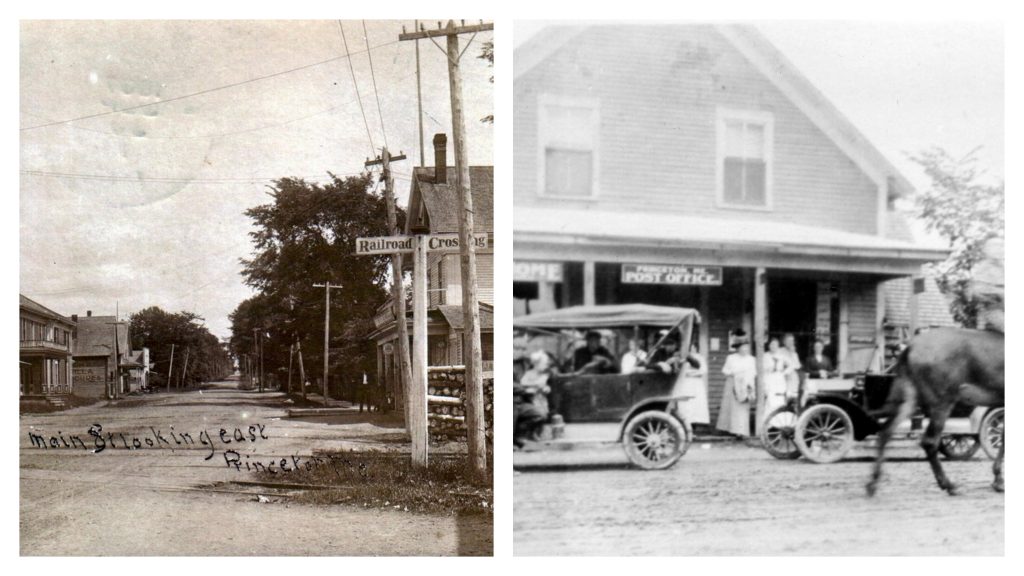
We’ll finish with an 1890 story from Princeton which made national headlines.
1890 Santa Barbara California Independent
Panther attacks Princeton man:
A Perilous Experience.
The people of Princeton, Me., were startled not long ago to learn that a terrible creature bad been seen lurking in the wood near town, A dispatch from Calais, Maine, to the Sacramento Bee, of the 19th, says Stephen Pike, the man who saw the animal, said it was a panther. His story, however, was discredited, but it has been substantiated by a lumberman who live near Princeton. While on the way home a night or two ago, he encountered the ugly beast in the woods. The animal immediately shewed fight, springing upon the lumberman with great ferocity. The man had nothing to defend himself with but an ax, and was almost unnerved by the suddenness of the attack. Being a hardy fellow be quickly swung the keen edged ax. For a moment or two the battle waged fiercely. The sharp claws of the panther several times caught the man’s clothing, tearing it into shreds and cutting into the flesh, while the agility of the animal prevented an effective use of the axe. Finally by a well-directed blow the woodsman struck the right forefoot of the panther, entirely severing it. With a yell the animal withdrew from the duel. It is thought that it is the animal that was seen by Mr. Pike, but the hero of the encounter describes it as much more formidable, saying it was as large as a yearling calf and not one of its leaps was less than five yards. In proof of his statement the lumberman forwarded the ‘foot of the beast to this city, where it is on exhibition.”
It’s hard to know what to make of this tale unless you know the characters involved and here Bruce Belmore’s history of Princeton provides some guidance. Of Steve Pike he says:
Big boys, such as Steve Pike, Wint Lovering, and “Dixie Bill” Crosby, and still bigger ones, such as Ott Brown, Si McDougall and Joe McLaughlin, were racing old nags —the Pike hoys had a half-hipped one — up and down Princeton’s Main Street; and to this category in all justice must be added the name of Lot Lawler, feminine horse fan. The old folks thought the speed of six to eight miles on Main Street was outrageously dangerous, and tried to put a stop to it. And these same big boys now and then might be seen sneaking behind somebody’s barn or henpen, there to promote wicked cock-fights.
We cannot say for certain that Steve Pike is an unreliable reporter of events but we do have questions as there has never, as far as we are aware, been a sighting of a panther in New England [editor’s note: mountain lions, which are the genetic equivalent of panthers, are occasionally sighted in New England is rare circumstances], so it seems unlikely such a beast would have traveled all the way to Princeton to attack Steve. We can’t tell you a lot about him other than his father was Oscar Pike and his mother Julia Minnie Crosby. He was last sighted in Seattle Washington in 1900. The Pikes were also postmasters in Princeton and it was perhaps an uncle who would have worked at the Princeton Post Office pictured above. The photo on the right is obviously not an 1880s photo of the town but does feature a horse, perhaps the offspring of one of Steve’s “racing old nags”. The reference to “half hipped one” eludes us entirely.
